
Paektu Mountain or Baekdu Mountain is an active stratovolcano on the Chinese–North Korean border. In China, it is known as Changbai Mountain. At 2,744 m (9,003 ft), it is the tallest mountain in North Korea and Northeast China and the tallest mountain of the Baekdu-daegan and Changbai mountain ranges. The highest peak, called Janggun Peak, belongs to North Korea. The mountain notably has a caldera that contains a large crater lake called Heaven Lake, and is also the source of the Songhua, Tumen, and Yalu rivers. Korean and Manchu people assign a mythical quality to the mountain and its lake, and consider the mountain to be their ancestral homeland.
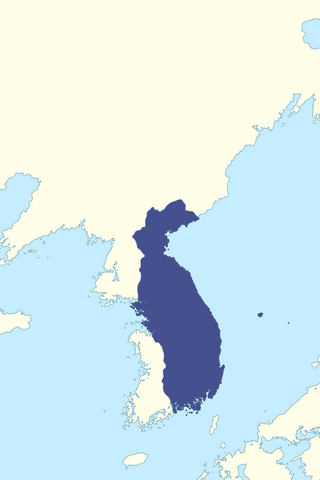
Silla, alternatively Shilla, was a Korean kingdom that existed between 57 BCE – 935 CE and located on the southern and central parts of the Korean Peninsula. Silla, along with Baekje and Goguryeo, formed the Three Kingdoms of Korea. Silla had the lowest population of approximately 850,000 people, which was significantly smaller than those of Baekje and Goguryeo.

Mount Kōya is a large temple settlement in Wakayama Prefecture, Japan to the south of Osaka. In the strictest sense, Mount Kōya is the mountain name (sangō) of Kongōbu-ji Temple, the ecclesiastical headquarters of the Kōyasan sect of Shingon Buddhism.
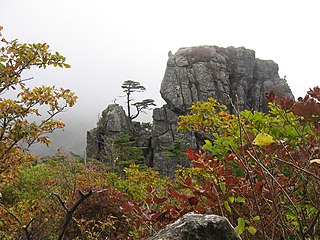
Jirisan (Korean: 지리산) is a mountain located in the southern region of South Korea. It is the second-tallest mountain in South Korea after Jeju Island's Hallasan, and the tallest mountain in mainland South Korea.
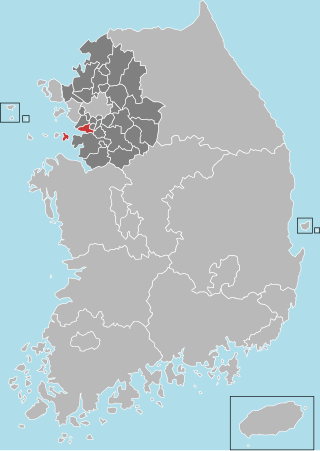
Ansan is a city in Gyeonggi Province, South Korea. It lies southwest of Seoul and is part of the Seoul National Capital Area. It is connected to Seoul by rail via Seoul Subway Line 4. It is situated on the Yellow Sea coast and some islands lie within its jurisdiction. The largest and best-known of these is Daebu Island.
Haneuljae, also known as Gyerimnyeong (계립령/鷄立嶺) is a mountain pass in the Sobaek Mountains of central South Korea. It runs between Chungju city in North Chungcheong province and Mungyeong city in North Gyeongsang province. Haneuljae rises to about 530 metres (1,740 ft) above sea level, between the peaks of Poam Mountain and Juheul Mountain.
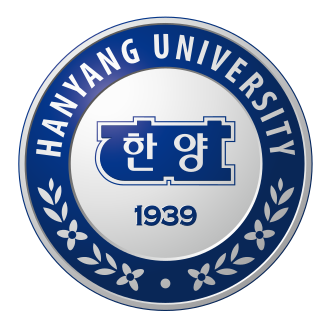
Hanyang University is a private prestigious research university in Seoul and Ansan, South Korea. Hanyang derives from the former name of the capital Seoul used during the Joseon Dynasty. The university was founded in 1939 as an engineering school, and was the country's first college to offer engineering and architecture programs.

Baekdu-daegan is a traditional Korean conception of the mountains and consequently the watersheds of the Korean peninsula. The mountain range stretches the length of the Korean peninsula, around 1500 km, from Baekdu Mountain in the north to Jirisan or Hallasan on Jeju Island in the south. The mountain range is often associated with national identity and traditional Korean shamanism.

Jikjisa is a head temple of the Jogye Order of Seon Buddhism. It is located on the slopes of Hwangaksan in Daehang-myeon, Gimcheon, North Gyeongsang Province, South Korea. It may be one of the oldest temples in South Korea.

Ssanggyesa is a head temple of the Jogye Order of Korean Buddhism. It is located on the southern slopes of Jirisan, southwest of sacred Samshin-bong Peak, in the Hwagye-dong Valley of Hwagae-myeon, Hadong County, in the province of Gyeongsangnam-do, South Korea.
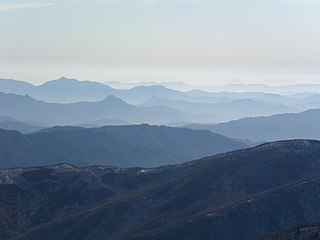
Deogyusan (Korean: 덕유산), formerly spelled Togyusan, is a mountain in South Korea. Its highest peak is 1,614 meters above sea level.
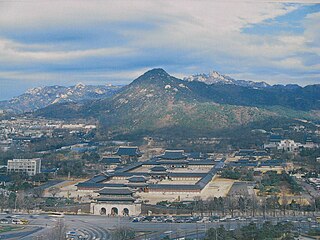
Jongno District is a district in Downtown Seoul, South Korea. It is the historic center of Seoul, and contains the Joseon-era royal palace Gyeongbokgung and the former presidential residence, the Blue House.

Odaesan, also known as Mount Odae-san or Mount Odae, is a major cluster of mountains and national park in eastern Gangwon Province, South Korea, standing at the junction of Gangneung City, Pyeongchang County and Hongcheon County. It stands at the junction of the Taebaek Mountains and the Charyeong Mountains, a spur range stretching to the west and serving to divide the South Han River / Namhan River from the North Han River / Bukhan River. It stands just to the south of Seoraksan and north of Dutasan along the Baekdu-daegan Mountain-system mainline, the range of granite peaks that make up the symbolic spine of the Korean Peninsula, but its peaks are more rounded and forested than most. National Highway 6 runs through the park, between the south main-entrance and the northeast corner descending to the east coast. It contain five main peaks surrounding a deep main valley running north to south, and several other subsidiary peaks, such as Noin-bong, with gorges between, a watershed forming a river leaving this area to the south. Just outside the western boundary of the national park area, another mountain Gyebang-san rises to 1,577 m (5,174 ft), higher than conventional Odae-san's summit, and they are connected by a 10 km long ridge; it is controversial whether or not to include this within the cluster or consider it as separate.

Sacred mountains are central to certain religions, and are usually the subjects of many legends. For many, the most symbolic aspect of a mountain is the peak because it is believed that it is closest to heaven or other religious realms. Many religions have traditions centered on sacred mountains, which either are or were considered holy or are related to famous events. In some cases, the sacred mountain is purely mythical, like the Hara Berezaiti in Zoroastrianism. Mount Kailash is believed to be the abode of the deities Shiva and Parvati, and is considered sacred in four religions: Hinduism, Bon, Buddhism, and Jainism. Volcanoes, such as Mount Etna in Italy, were also considered sacred, Mount Etna being believed to have been the home of Vulcan, the Roman god of fire and the forge.

Taebaeksan, also known as Mount Taebaeksan or Mount Taebaek, is a South Korean mountain with several important peaks of the Taebaek mountain range, or the Taebaek Jeongmaek Range. It is an important mountain in the Baekdu-daegan mountain range, the point where it turns west after running along Korea's east coast for a long distance. Its territory stretches from the city of Taebaek in Yeongwol-gun County, Gangwon-do Province to Bonghwa-gun County, Gyeongsangbuk-do Province, and it was designated South Korea's 22nd national park on 22 August 2016. It has an elevation of 1,566.7 m (5,140 ft).
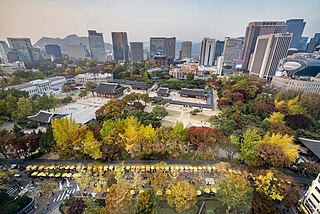
Seoul, officially Seoul Special City, and formerly known as Hanseong and Keijō, is the capital of the Republic of Korea (ROK), commonly known as South Korea, and the country's most extensive urban center. The broader Seoul Capital Area, encompassing Gyeonggi province and Incheon metropolitan city, emerged as the world's fourth largest metropolitan economy in 2014, trailing only Tokyo, New York City, and Los Angeles, hosting more than half of South Korea's population. Although Seoul's population peaked at slightly over 10 million, it has gradually decreased since 2014, standing at approximately 9.97 million residents as of 2020. Seoul is the seat of the South Korean government.

Mountain Gods (山神) are Asian tutelary deities associated with mountains. They are related to landlord deities and tudigongs and City Gods.

Doseon Guksa was a Korean Buddhist monk (826-898) who lived during the decline of the Silla Dynasty, just prior to the foundation of the Goryeo Dynasty. At least 70 temples, monasteries and hermitages are claimed to have been founded either under Doseon's supervision and direction, or by orders of Taejo of Goryeo following Doseon's recommendations.
The Five Mountains of Korea are five renowned mountains in Korean culture.

The Paektusan Secret Camp is claimed to be a former military base on Mount Paektu, and the claimed birthplace of Kim Jong-Il, though he was born in the USSR. The North Korean government claims that it played an important role in the resistance against the Japanese occupation of the Korean Peninsula, and was occupied by the Korean People's Revolutionary Army. Official photos and descriptions of the location depict there being a log cabin and several barracks at the site. They also describe a monument with a poem dedicated to Kim Jong-Il and allegedly written by Kim Il-Sung located near the camp. The location is currently used to support both Kim Il-Sung and Kim Jong-Il's cult of personality.

















